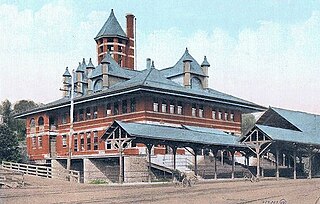 W
WAllentown was a train station in Allentown, Pennsylvania. It was opened by the Lehigh Valley Railroad in 1890 and closed in 1961. The building was demolished in 1972. The station was located one block west of the Central Railroad of New Jersey's Allentown station.
 W
WThe Union Station built in 1930 in Atlanta was the smaller of two principal train stations in downtown, Terminal Station being the other. It was the third "union station" or "union depot", succeeding the 1853 station, burned in mid-November 1864 when Federal forces left Atlanta for the March to the Sea, and the 1871 station.
 W
WThe Australia Hotel was a hotel on Castlereagh Street, Sydney in New South Wales, Australia. From its opening in 1891 until its closure on 30 June 1971 and subsequent demolition, the hotel was considered "the best-known hotel in Australia", "the premier hotel in Sydney" and described itself as "The Hotel of the Commonwealth". The hotel was situated in one of Sydney's important thoroughfares in the Sydney central business district.
 W
WThe Baum Building was a historic building in Oklahoma City, Oklahoma. In 1909, Moses J. Baum, a Mississippi-born merchant who specialsed in women's garments, leased the land at the northeast corner of Grand and Robinson and built a five-story commercial building on the site. The building was modeled after the Doge's Palace in Venice, Italy. The building was completed in 1910, with the Baum company moving in on May 5th, 1910. The building was designed by Layton and Smith and cost $140,000 to build.
 W
WCastlemilk House was a country house located in what is now the Castlemilk district of Glasgow, Scotland. The house was the ancestral home of the Stirling-Stuart family and was built around the 15th-century Cassiltoun Tower during the 18th and 19th centuries. The house and Castlemilk Estate were purchased by Glasgow Corporation in 1938, with the house serving as a children's home until it was closed in 1969 and demolished that year.
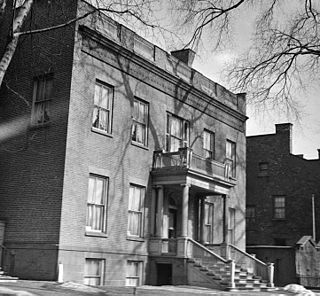 W
WThe Dr. Hun Houses were located on Washington Avenue on the western edge of central Albany, New York, United States. They were a pair of brick buildings constructed a century apart, the older one around 1830, in the Federal style. In 1972, three months after they were listed on the National Register of Historic Places, they were demolished and subsequently delisted.
 W
WThe Esplanade Hotel was a hotel on The Esplanade across from Esplanade Reserve in Perth, Western Australia. Its demolition in 1972 was controversial because of the building's beauty and popularity.
 W
WThe Grein Building, also known as the Waverly Block, Business Men's Association Building, BMA Building, or Green Building, was constructed from 1887–1889 in Evansville, Indiana. It was designed by Reid & Reid and demolished in 1972. It was a 6-story brownstone and red granite Renaissance revival style building at 12 NW 2nd Street on the corner of 2nd Street and Sycamore Avenue.
 W
WThe Henry Grady Hotel was a 13-story hotel located at the corner of Peachtree Street and Cain St. in Atlanta from 1924-1972. The architect was G. Lloyd Preacher. It was named after Henry Grady, Georgia's most celebrated orator. It was built on the site of the third Georgia Governor's Mansion, previously the mansion of John H. James. After the Grady was demolished, the Westin Peachtree Plaza was built on the site.
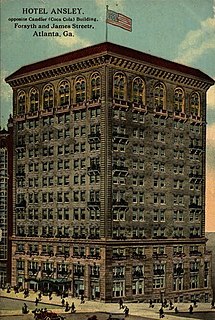 W
WThe Hotel Ansley was a hotel that occupied the south side of Williams Street between Forsyth and Fairlie streets in the Fairlie-Poplar district of Downtown Atlanta. It was built in 1913 by Jerome B. Pound of Chattanooga, TN and named for Edwin P. Ansley, developer of the Ansley Park neighborhood; an estimated 5000 guests attended the opening of the $1,000,000 property. The property was originally managed by M.I. and Frank Harrell.
 W
WThe Hotel Claridge was a 16-story building on Times Square in Manhattan, New York City, at the southeast corner of Broadway and 44th Street. Originally known as the Hotel Rector, it was built of brick in the Beaux-arts style in 1910–1911. The 14-story building had 240 guest rooms and 216,000 square feet of space. It operated for 61 years until the building was demolished in 1972.
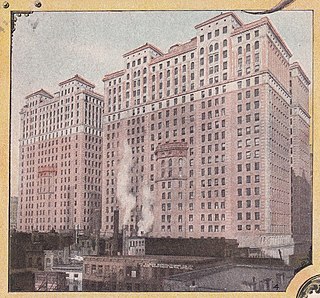 W
WHudson Terminal was a rapid transit station and office-tower complex in the Radio Row neighborhood of Lower Manhattan in New York City. Opened during 1908 and 1909, it was composed of a terminal station for the Hudson & Manhattan Railroad (H&M), as well as two 22-story office skyscrapers and three basement stories. The complex occupied much of a two-block site bounded by Greenwich, Cortlandt, Church, and Fulton Streets, which later became the World Trade Center site.
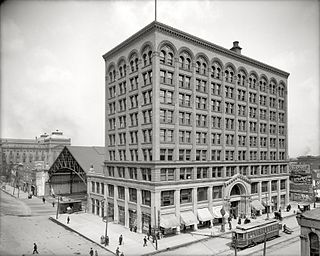 W
WThe Indianapolis Traction Terminal was a major interurban train station in downtown Indianapolis, Indiana. It was the largest interurban station in the world and at its peak handled 500 trains per day and seven million passengers per year. The station opened in 1904 and remained in use until 1941, when interurban operation ended. It continued to serve as a bus station until 1968 and was demolished in 1972. The Hilton Indianapolis now stands at its location.
 W
WKönigs Wusterhausen Central Tower was a 243 m (797 ft), freestanding steel framework tower on the Funkerberg of Königs Wusterhausen, Germany. The tower, with its unique triangular cross section, was built from 1924 to 1925. The tower collapsed during the storm Quimburga on 13 November 1972.
 W
WNortheast Library is a public library in Minneapolis, Minnesota, United States. It is part of the Hennepin County Library system. Since opening in 1973, Northeast Library at 2200 Central Avenue Northeast in Minneapolis serves a vibrant metropolitan community, Northeast, Minneapolis. At 15,275 square feet, the space held about 30,000 books and featured a fireplace to welcome patrons in winter. The 1973 building was itself a replacement for a Carnegie library which was on the site from 1915 until 1972.
 W
WNorwood College was a private boys' school located in Harrogate, North Yorkshire, England. It was founded on 8 May 1936, by Gordon William George Cass, a former teacher, known as "Charlie" to his pupils. The school was on a corner site with the original part in Tewit Well Avenue and the later part in Leeds Road, close to The Stray.
 W
WThe Old Toronto Star Building was an Art Deco office tower in Toronto, Ontario, Canada. The building was located at 80 King Street West and was the headquarters of the Toronto Star newspaper from 1929 until 1970. The building was demolished in 1972 to make way for the construction of First Canadian Place.
 W
WThe Oriana Cinema was an art deco cinema and theatre built in 1938 in Fremantle, Western Australia and demolished in the early 1970s.
 W
WThe Wendell O. Pruitt Homes and William Igoe Apartments, known together as Pruitt–Igoe, were joint urban housing projects first occupied in 1954 in the US city of St. Louis, Missouri. Living conditions in Pruitt–Igoe began to decline soon after completion in 1956. By the late 1960s, the complex had become internationally infamous for its poverty, crime and racial segregation. The 11-story high rises within the complex almost exclusively accommodated African-Americans. All 33 buildings were demolished with explosives in the mid-1970s, and the project has come to represent some of the failures of urban renewal, public-policy planning and public housing.
 W
WThe Queen City Hotel was constructed in 1871 by the Baltimore and Ohio Railroad (B&O) in Cumberland, Maryland to serve both as a train station and as a destination. Hosting 174 rooms, it also had such features as formal gardens with a fountain, a ballroom and 400-seat dining room. It was torn down in 1972 to make room for a new main United States Post Office and Distribution facility with a much smaller station for Amtrak service between the new Post Office and the railroad tracks.
 W
WShip Island Light was a lighthouse in Mississippi near Gulfport.
 W
WShiremark Mill, also known as Kingsfold Mill or Capel Mill was a listed Smock mill at Capel, Surrey, England, which was burnt down in 1972.
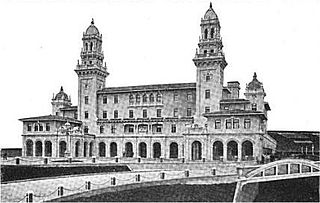 W
WTerminal Station was the larger of two principal train stations in downtown Atlanta, Union Station being the other. Opening in 1905, Terminal Station served Southern Railway, Seaboard Air Line, Central of Georgia, and the Atlanta and West Point. The architect was P. Thornton Marye, whose firm also designed the Fox Theater and Capital City Club in downtown Atlanta, as well as the Birmingham Terminal Station.
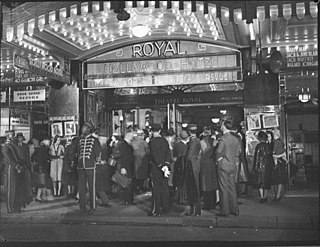 W
WThe Theatre Royal is a theatre in Sydney, Australia built in 1976. It has offered a broad range of entertainment including dramas, comedy and especially musicals since the 1990s. The theatre has been closed since March 2016, but is scheduled to reopen December 2021 under parent company Trafalgar Entertainment.
 W
WThe Traymore Hotel was a resort in Atlantic City, New Jersey. Begun as a small boarding house in 1879, the hotel expanded and became one of the city's premier resorts. As Atlantic City began to decline in its popularity as a resort town, during the 1950s and 1960s, the Traymore diminished in popularity. By the early 1970s the hotel was abandoned and severely run down. It was imploded and demolished between April and May 1972, a full four years before the New Jersey State legislature passed the referendum that legalized gambling in Atlantic City.
 W
WThe Vsegradsky cathedral was one of the main historical monuments in Vologda. It was rebuilt from a wooden church in 1688–1698, which was established after a severe plague outbreak in 1654. The cathedral had the revered Icon «Saviour, the Most Merciful (everyday)».